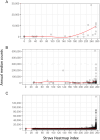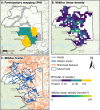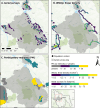Advancements in monitoring: a comparison of traditional and application-based tools for measuring outdoor recreation
- PMID: 39282110
- PMCID: PMC11397128
- DOI: 10.7717/peerj.17744
Advancements in monitoring: a comparison of traditional and application-based tools for measuring outdoor recreation
Abstract
Outdoor recreation has experienced a boom in recent years and continues to grow. While outdoor recreation provides wide-ranging benefits to human well-being, there are growing concerns about the sustainability of recreation with the increased pressures placed on ecological systems and visitor experiences. These concerns emphasize the need for managers to access accurate and timely recreation data at scales that match the growing extent of the recreation footprint. Here, we compare spatial and temporal patterns of winter and summer recreation using traditional (trail cameras, infrared counters, aerial surveys, participatory mapping) and application-based tools (Strava Metro, Strava Global Heatmap, Wikiloc) across the Columbia and Canadian Rocky Mountains of western Canada. We demonstrate how recreation use can be estimated using traditional and application-based tools, although their accuracy and utility varies across space, season and activity type. We found that trail cameras and infrared counters captured similar broad-scale patterns in count estimates of pedestrians and all recreation activities. Aerial surveys captured areas with low recreation intensity and participatory mapping captured coarser information on the intensity and extent of recreation across large spatial and temporal scales. Application-based data provided detailed spatiotemporal information on recreation use, but datasets were biased towards specific activities. Strava Metro data was more suited for capturing broad-scale spatial patterns in biking than pedestrian recreation. Application-based data should be supplemented with data from traditional tools to identify biases in data and fill in data gaps. We provide a comparison of each tool for measuring recreation use, highlight each tools' strengths and limitations and applications to address real-world monitoring and management scenarios. Our research contributes towards a better understanding of which tool, or combinations of tools, to use that can expand the rigor and scope of recreation research. These findings support decision-making to mitigate pressures on wildlife and their habitats while allowing for high-quality recreation experiences.
Keywords: Aerial surveys; App-based data; Camera traps; Participatory mapping; Recreation monitoring; Trail counters; User-generated data; Volunteered geographic information; Wildlife and recreation management.
©2024 Vilalta Capdevila et al.
Conflict of interest statement
The authors declare there are no competing interests.
Figures









References
-
- Alberta Government Human and wildlife coexistence: recommendations for improving human-wildlife coexistence in the Boy valley. 2018. https://www.alberta.ca/bow-valley-human-wildlife-coexistence-engagement#.... [20 January 2024]. https://www.alberta.ca/bow-valley-human-wildlife-coexistence-engagement#...
-
- Brown G. Public participation GIS (PPGIS) for regional and environmental planning: reflections on a decade of empirical research. Journal of the Urban and Regional Information Systems Association. 2011;24:7–17.
Publication types
MeSH terms
LinkOut - more resources
Full Text Sources

